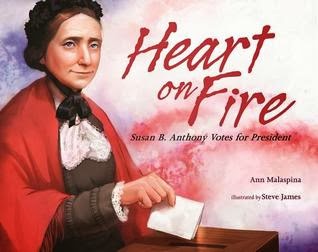Summary:
Heart on Fire depicts the uphill struggle that Susan B.
Anthony faced in order to gain the right to vote. When the time to register came, Susan B.
Anthony quickly made her way to town hall because under the
Constitution, “All persons born in the United States have the same rights, as
citizen" and she felt this also applied to women and the right to vote. Her registration was eventually granted, and on voting day Susan B.
Anthony cast her vote along with several women.
However, several days later all of the women were arrested for voting illegally.
Before her trial she toured the country trying to gain support for women’s
rights and gained a great deal of encouragement.
Unfortunately, on the day of her trial she was found guilty; however,
she believed so strongly in her rights that she refused to pay her court fine or go to jail. Instead, she continued to advocate for women for years to come until June 4, 1919, when the Nineteenth
Amendment would eventually be passed, giving women the right to
vote.
Element IV: Social
Movements and Social Change
This book is a wonderful depiction of Element IV because it
clearly discusses the social injustice against women, but focuses on the pride
women, such as Susan B. Anthony, had and the efforts they made to end this social
injustice. This is a story of
encouragement and helps to showcase the ability that one person has to make a
difference. While it took many people to
eventually pass the Nineteenth Amendment, it started with the persistent voice
of several women who believed very strongly in something and wanted to make a
difference. Just like our students,
Susan B. Anthony was just an ordinary woman, and yet, she helped to change the
world in a more positive way. This book
teaches all students, not just females, that they should stand up for the
things that they believe in and they too have the power to make a change.
Classroom Activity:
Class Vote: The teacher will facilitate a classroom vote for
a topic of her choosing and allow both the boys and the girls in the classroom the opportunity to cast their vote.
The teacher will then review the results and determine what the outcome
is when both parties get to vote.
Following that, the teacher should take away all of the girl’s votes and
see if that changes the results. For the
sake of the lesson, the teacher could then reverse the roles/situation and take
away the boy’s votes (leaving the girl’s votes) and see if that alters the
results. Depending on whether or not the
outcome changes, the discussion may vary, but the teacher can facilitate a
follow up discussion asking the girls and boys how they felt knowing their vote
would not count. This can be tied into
the importance of having a democratic classroom today and why each of the
students are allowed to have a voice and share their thoughts and
opinions with the class.

No comments:
Post a Comment